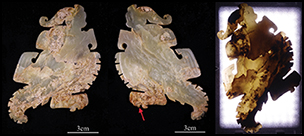Article contents
A jade parrot from the tomb of Fu Hao at Yinxu and Liao sacrifices of the Shang Dynasty
Published online by Cambridge University Press: 24 April 2018
Abstract

The importance of jade in the burnt offerings of the Shang Dynasty known as ‘Liao sacrifice’ has long been known from documentary evidence, but has yet to be scientifically verified. We present the results of non-destructive analyses of a jade parrot excavated from the tomb of imperial consort Fu Han at Yinxu in Henan Province. Analyses revealed the presence of diopside, an outcome of phase transition from tremolite resulting from heating in antiquity. This provides the first scientific evidence that the Shang Dynasty used jade in Liao sacrifice, and confirms oracle bone inscriptions and later records concerning the ritual.
- Type
- Research
- Information
- Copyright
- Copyright © Antiquity Publications Ltd, 2018
References
- 7
- Cited by


